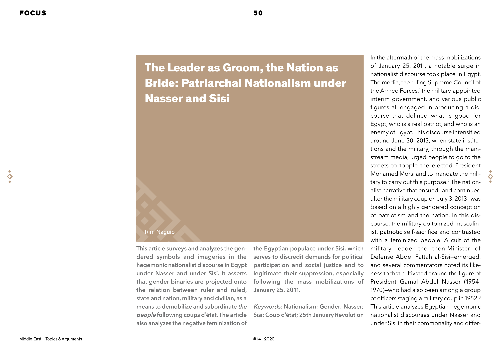The Leader as Groom, the Nation as Bride. Patriarchal Nationalism under Nasser and Sisi
This article surveys and analyzes the gendered symbols and imageries in the hegemonic nationalist discourse in Egypt, under Nasser and under Sisi. It advances that gender binaries are projected onto the relation between ruler and ruled, state and nation, military and civilian, as a means to demobili...
I tiakina i:
| I whakaputaina i: | Middle East - Topics & Arguments |
|---|---|
| Kaituhi matua: | |
| Hōputu: | Artikel (Zeitschrift) |
| Reo: | Ingarihi |
| I whakaputaina: |
Philipps-Universität Marburg
2020
|
| Ngā marau: | |
| Urunga tuihono: | Urunga tuihono |
| Tags: |
Tag hinzufügen
Keine Tags, Fügen Sie den ersten Tag hinzu!
|
| Whakarāpopototanga: | This article surveys and analyzes the gendered symbols and imageries in the hegemonic nationalist discourse in Egypt, under Nasser and under Sisi. It advances that gender binaries are projected onto the relation between ruler and ruled, state and nation, military and civilian, as a means to demobilize and subordinate “the people” following coups d’état. The article also analyzes the negative feminization of the Egyptian populace under Sisi, which serves to discredit demands for political participation and social justice and to legitimate their suppression, especially following the mass mobilizations of January 25, 2011. |
|---|---|
| DOI: | 10.17192/meta.2020.14.8232 |
 Publikationsserver
Publikationsserver